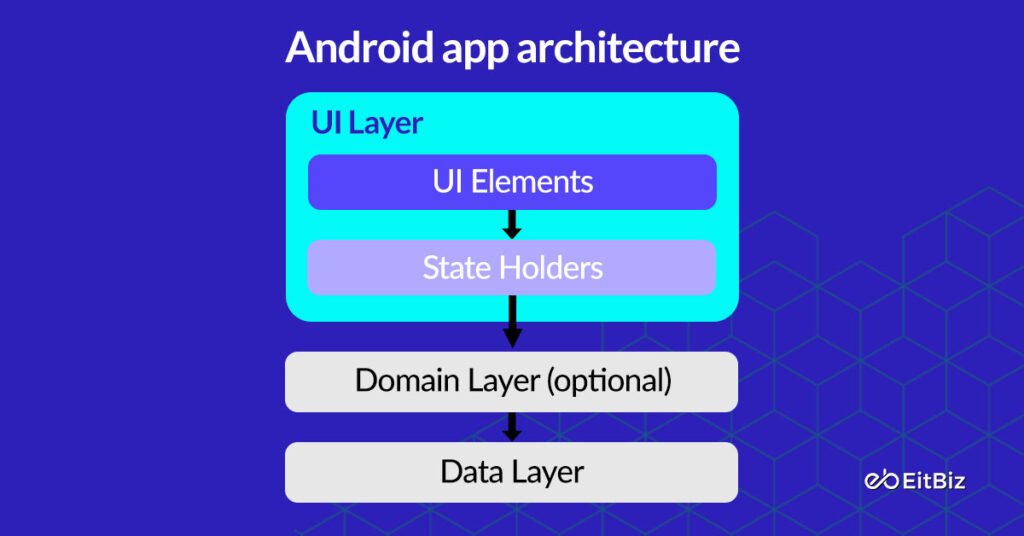Mobile app development!
It is not just a “term” anymore! Instead, every organization wants to be a part of it to improve its branding and reap abundant benefits.
And why they shouldn’t be?
Did you know?
There are more than 3.48 million apps on the Google Play Store and over 2.22 million apps on the Apple App Store. (Source: Statista).
Considering such facts, it is no secret why businesses are going crazy over “Mobile App Development”!
But at the same time, it’s wise to understand that the competition is fierce!
Now the question arises- How to stay ahead of the competition? How to build a mobile app that surpasses the competition?
That’s why, this post has come to the rescue to help you go through mobile architecture in detail!
Let’s dive in!
| Table Of Contents: 1. What is “Mobile App Architecture”? 2. What are the Key Layers of Mobile App Architecture? 3. What are the Different Types of Mobile Application Architecture? Final Thoughts |
What is “Mobile App Architecture”?
To put it simply, mobile app architecture refers to the predefined set of tools, guidelines, methods, designs, and techniques required to build a mobile application. It simply serves as a roadmap for developers to create a structured and well-positioned app without running into complexities.
If you, however, want to build a complex or large-sized app, the complexity of the mobile app architecture will also grow. But going down in the long run it would ultimately help you save longer development time, testing challenges, errors, and enhanced expenses.
Though the mobile app architecture is incredibly important, some people (or even beginner professionals) might confuse it with the mobile stack.
Is it the same as the mobile stack? Well, absolutely not!
Mobile app architecture is nothing but just an outline of a mobile application but, on the other hand, a mobile tech stack is a group of technical frameworks that combine the front-end and back-end of the mobile application.
What are the Key Layers of Mobile App Architecture?

Here is a list of the key layers of mobile app architecture.
#1. Presentation Layer
One of the important yet popular layers of mobile app architecture is that it consists of all essential components to deliver the app to the user. This layer is made up of the user interface (UI) and user experience (UX). The former deals with design aspects such as colours, fonts, and complete design while the latter manages the way a customer interacts with the app.
When it comes to designing the presentation layer, developers should choose the right platform and type of device. If you don’t have dedicated developers, hire UI UX design company to build the UX and UI aspects of the application.
#2. Business Layer
It is another popular layer of mobile app architecture that deals with logic and rules applicable to data exchange, operations, and workflow regulations. Developers can use the layer for a wide range of activities such as data caching, logging, security, data validation, and more.
Furthermore, this layer can exist on the server, depending on the type and operations of the app.
#3. Data Layer
It is another major mobile app architecture layer that includes all data utilities, service agents, and data access components to support a wide range of data transactions. It is further divided into two sections- Persistence (Data Access with data sources via API) and network (routing, networking communication, and reporting of errors).
After discussing the layers of mobile app architecture, it’s time to understand the architecture of different types of mobile apps.
Without further ado, let’s dive in!
What are the Different Types of Mobile Application Architecture?
Listed below are the different types of mobile app architecture that you should know!
#1. Android Mobile App Architecture

For Android app development architecture, using a clean architecture is important to build an Android app. In such kind of architecture, it is built on the principles of layers which may help eliminate the need for your application’s database, frameworks, and other crucial components. Not only does it help support the installation of multiple plugins but it may also enable hassle-free troubleshooting.
Gone are the days when developers didn’t have any libraries to work with the network. But in today’s landscape, the implementation of clean architecture is an ideal solution.
#2. iOS Mobile App Architecture
When it comes to iOS mobile app development, developers use Objective-C and Swift for different industry verticals. Generally, an iOS mobile app architecture is further classified into 4 major parts, which may include;
- Media Level: It includes tools for processing all types of media formats.
- Interface Level: Also known as Cocoa Touch, it mainly being used to develop multiple interfaces and even provides information about layers that a user provides.
- Core Services: It offers direct access to database and file controls.
- Core OS: It functions directly and precisely with the file system. Also known as the Kernel Level, it easily monitors and manages the credibility of the app certificates.
Note: If you want to build a high-quality iOS mobile app architecture, you should ask your developers to add an MVC (Massive View Controller) and its prototype.

#3. Hybrid Mobile App Architecture
Hybrid apps are a combination of both online and native solutions. These apps use native apps as “Shells” for the back end but platform-neutral JavaScript, HTML, and CSS for the front end. Furthermore, these apps efficiently use a single codebase for different mobile platforms.
One of the interesting aspects of these apps is that they are the fastest to operate but they are not ideal for complex or feature-rich apps.
#4. Cross-Platform App Architecture
If you are a startup or even a medium-scale business on a tight budget then this cross-platform app architecture would be an ideal choice. When your mobile app is built on cross-platform architecture, it will likely offer a cost-effective and robust solution. When it comes to cross-platform mobile app development, you can choose either React or Flutter and enjoy optimal performance.
Now that you have understood the layers and architecture of mobile app development, it’s time to make your every move worth your effort.
Remember that if you are not building a mobile app as per the latest trends, you will likely going to lose in the long run.
Without further ado, let’s discuss the top mobile app trends to consider for your business.
Top Mobile App Development Trends To Watch Out in 2025
Here is a list of the top mobile app trends to consider in your mobile app development project.
- 5G Technologies
- IoT App Integration
- Touchless UI
- Mobile Commerce
- Artificial Intelligence
- Voice Recognition
- Cross-Platform App Development
- ChatBots
- Cloud Computing
Implementing these modern app development trends may help you establish a robust market foothold and an edge over your competition.
Final Thoughts
So, there you have it! That’s a wrap to the complete mobile app architecture in 2025! It is no secret that designing an ideal mobile app architecture is important for the growth of an app.
Whether you are a startup or an established business, choosing the right application architecture has the potential to render tangible business results.
Planning to build mobile app architecture? If so, look no further than a seasoned mobile app development agency, i.e., EitBiz! Partner with EitBiz and build an efficient mobile app architecture for your business. Drop us an email at info@eitbiz.com or call us at +1(812)530-6300 today!







